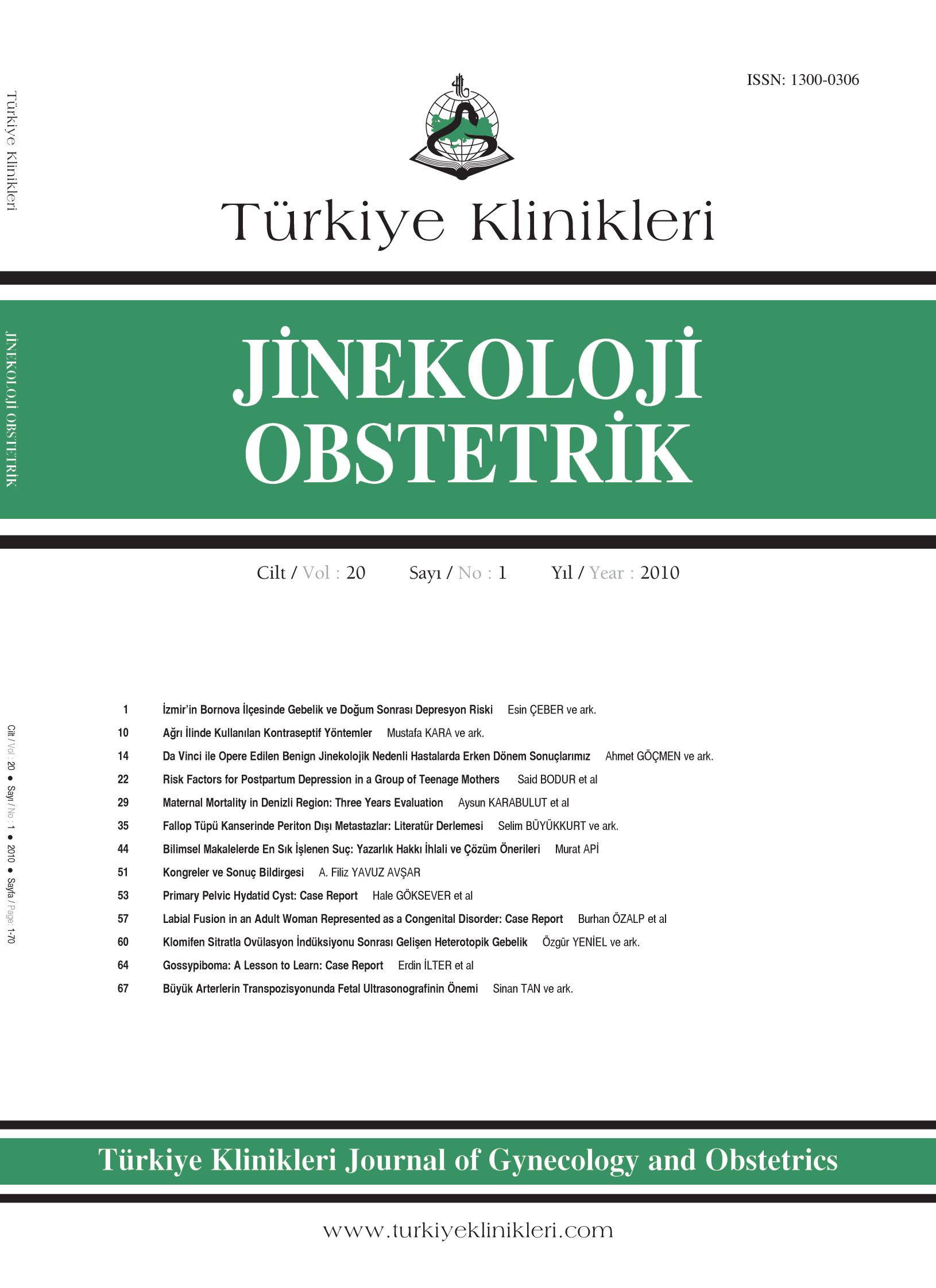Open Access
Peer Reviewed
REVIEW
3557 Viewed1208 Downloaded
Extraperitoneal Metastasis of the Fallopian Tube Cancer: A review of the Literature
Fallop Tüpü Kanserinde Periton Dışı Metastazlar: Literatür Derlemesi
Turkiye Klinikleri J Gynecol Obst. 2010;20(1):35-43
Article Language: TR
Copyright Ⓒ 2025 by Türkiye Klinikleri. This is an open access article under the CC BY-NC-ND license (http://creativecommons.org/licenses/by-nc-nd/4.0/)
ÖZET
Fallop tüpü kanseri oldukça nadir görülür, onun periton dışı metastazları ise daha da ender bir durumdur. Fallop tüpü kanseri hakkındaki bilgilerin büyük kısmı klinik olarak büyük benzerlikleri olan epitelyal over kanserinden elde edilmiştir. Hastalık batın içi organların peritoneal yüzeylerine, tümör hücrelerinin periton boşluğuna dökülmesiyle yayılmaktadır. Periton dışı metastazlar için ise lenfojen ve hematojen yolların neden olduğu düşünülmektedir. Bu çalışmada, periton dışına yayılan fallop tüpü kanserlerine ait bilgiler derlenmiştir. Olguların büyük kısmı cerrahi ve kemoterapiyle tedavi edilmiştir. Diğer taraftan konuyla ilgili yayınlanmış ilk çalışmalarda olguların radyoterapi veya intraperitoneal kemoterapi ile tedavi edildiği bildirilmektedir. Lenf bezleri en sık tutulan periton dışı odaklardır. Akciğerler ve santral sinir sistemi ise çoğu kez birlikte tutulmaktadır. Santral sinir sistemi tutulumları çoğu kez bir nörolojik semptomu araştırırken saptanmıştır. Bu da santral sinir sistemi tutulumlarının asemptomatik olgularla birlikte daha da fazla olabileceğini düşündürmektedir. Kemik, karaciğer, dalak, deri, plevra, perikard ve meme de tutulum gösteren diğer periton dışı yerlerdir. Periton dışı nüksler ortalama 37.5 ± 21.2 (7-74) ay sonra ortaya çıkmaktadırlar. Periton dışı metastazlar ortaya çıktıktan sonraki sağkalım süresi ise 21.8 ± 21.0 (0.5-72) ay olarak hesaplanmıştır. Olguların bir kısmında periton dışı yayılım sırasında peritonda tümör saptanmamıştır. Her ne kadar periton dışı metastazlar ortaya çıktıktan sonra prognozun ileri derecede kötü olduğuna inanılsa da bazı olgular uzun süre yaşayabilmektedir.
Fallop tüpü kanseri oldukça nadir görülür, onun periton dışı metastazları ise daha da ender bir durumdur. Fallop tüpü kanseri hakkındaki bilgilerin büyük kısmı klinik olarak büyük benzerlikleri olan epitelyal over kanserinden elde edilmiştir. Hastalık batın içi organların peritoneal yüzeylerine, tümör hücrelerinin periton boşluğuna dökülmesiyle yayılmaktadır. Periton dışı metastazlar için ise lenfojen ve hematojen yolların neden olduğu düşünülmektedir. Bu çalışmada, periton dışına yayılan fallop tüpü kanserlerine ait bilgiler derlenmiştir. Olguların büyük kısmı cerrahi ve kemoterapiyle tedavi edilmiştir. Diğer taraftan konuyla ilgili yayınlanmış ilk çalışmalarda olguların radyoterapi veya intraperitoneal kemoterapi ile tedavi edildiği bildirilmektedir. Lenf bezleri en sık tutulan periton dışı odaklardır. Akciğerler ve santral sinir sistemi ise çoğu kez birlikte tutulmaktadır. Santral sinir sistemi tutulumları çoğu kez bir nörolojik semptomu araştırırken saptanmıştır. Bu da santral sinir sistemi tutulumlarının asemptomatik olgularla birlikte daha da fazla olabileceğini düşündürmektedir. Kemik, karaciğer, dalak, deri, plevra, perikard ve meme de tutulum gösteren diğer periton dışı yerlerdir. Periton dışı nüksler ortalama 37.5 ± 21.2 (7-74) ay sonra ortaya çıkmaktadırlar. Periton dışı metastazlar ortaya çıktıktan sonraki sağkalım süresi ise 21.8 ± 21.0 (0.5-72) ay olarak hesaplanmıştır. Olguların bir kısmında periton dışı yayılım sırasında peritonda tümör saptanmamıştır. Her ne kadar periton dışı metastazlar ortaya çıktıktan sonra prognozun ileri derecede kötü olduğuna inanılsa da bazı olgular uzun süre yaşayabilmektedir.
ABSTRACT
Fallopian tube cancer is a rare event and its extraperitoneal metastasis is even rarely seen. The most part of the knowledge about the fallopian tube cancer is derived from the epithelial ovarian carcinoma which has a very close similarity on clinical behavior. Disease usually disseminates to the peritoneal surfaces of the abdominal organs by exfoliation of the tumor cells in the peritoneal cavity. It is believed that the lymphogenic or hematogenous ways are the causes of extraperitoneal metastasis. We reported a review of the cases of fallopian tube cancer with extraperitoneal spreading. The majority of the patients were treated with combination of surgery and chemotherapy. On the other hand, the early reports state that the patients were treated with radiotherapy and intraperitoneal chemotherapy. Lymph node is the most common site for extraperitoneal dissemination. Lungs and central nervous system are usually involved synchronously. Central nervous system involvement is usually diagnosed while evaluating a neurological symptom. In this situation it is possible to emphasize that the central nervous system involvement is more common with asymptomatic patients. Bone, liver, spleen, skin, pleura, pericardium and breast are the other sites of extraperitoneal metastasis. The time interval for extraperitoneal recurrence was 37.5 ± 21.2 (7-74) months. The survival after the diagnosis of extraperitoneal metastasis 21.8 ± 21.0 (0, 5-72) is months. In some patients while extraperitoneal dissemination is detected, the peritoneal spread was absent. Although it is believed that when an extraperitoneal metastasis happened the prognosis is extremely poor, some patients may have a longer survival.
Fallopian tube cancer is a rare event and its extraperitoneal metastasis is even rarely seen. The most part of the knowledge about the fallopian tube cancer is derived from the epithelial ovarian carcinoma which has a very close similarity on clinical behavior. Disease usually disseminates to the peritoneal surfaces of the abdominal organs by exfoliation of the tumor cells in the peritoneal cavity. It is believed that the lymphogenic or hematogenous ways are the causes of extraperitoneal metastasis. We reported a review of the cases of fallopian tube cancer with extraperitoneal spreading. The majority of the patients were treated with combination of surgery and chemotherapy. On the other hand, the early reports state that the patients were treated with radiotherapy and intraperitoneal chemotherapy. Lymph node is the most common site for extraperitoneal dissemination. Lungs and central nervous system are usually involved synchronously. Central nervous system involvement is usually diagnosed while evaluating a neurological symptom. In this situation it is possible to emphasize that the central nervous system involvement is more common with asymptomatic patients. Bone, liver, spleen, skin, pleura, pericardium and breast are the other sites of extraperitoneal metastasis. The time interval for extraperitoneal recurrence was 37.5 ± 21.2 (7-74) months. The survival after the diagnosis of extraperitoneal metastasis 21.8 ± 21.0 (0, 5-72) is months. In some patients while extraperitoneal dissemination is detected, the peritoneal spread was absent. Although it is believed that when an extraperitoneal metastasis happened the prognosis is extremely poor, some patients may have a longer survival.
MENU
POPULAR ARTICLES
MOST DOWNLOADED ARTICLES





This journal is licensed under a Creative Commons Attribution-NonCommercial-NoDerivatives 4.0 International License.










